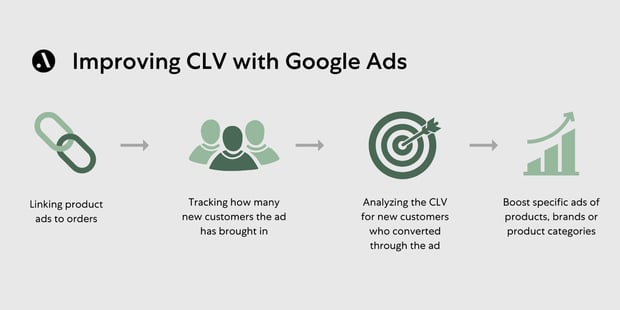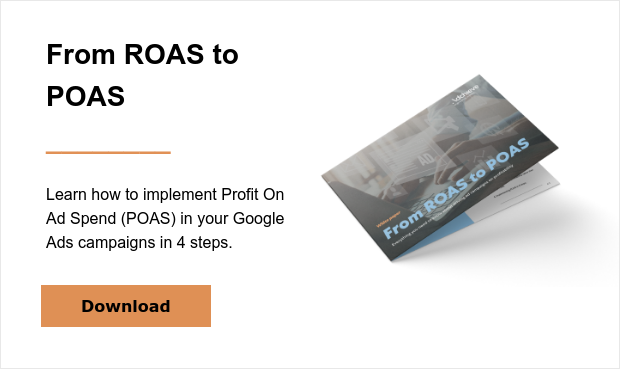What is Customer Lifetime Value?
Customer Liftetime Value, CLV for short, is the total value that a client generates for you over the entire period of actually being your client. While ROAS and POAS focus on the immediate impact on revenue from a specific campaign, CLV offers a much broader approach. With this KPI, you look at the impact on revenue over a much longer period of time.
Customer Lifetime Value within e-commerce
In practice, we see that Customer Lifetime Value is often an overlooked KPI. But once you know how to apply CLV properly, it yields promising insights and results.
If you are wondering why CLV is so important for e-commerce, just continue reading!
CLV provides:
- Insight into the real value of your clients
Suppose you spend €100 on an ad in Google Ads. That this ad creates a new client. And the new client earns you €70 in revenue on the first purchase. Odds are that you will find the investment too high for the revenue it generates.
But now imagine that the same client generates another €500 in revenue for you during the first year. This will probably change your mind about the investment. And this is precisely what CLV is all about. It helps you look beyond the plain data and gives you insight into the true value of your clients.
- Focus on the right clients
Not every client will generate the desired revenue for you. It is therefore worthwhile to focus on the existing and potential clients who will generate the most revenue. By calculating the CLV per client, you can manage your marketing efforts more effectively. For example, you can target ads to people who are similar to clients with a high CLV.
- More efficient distribution of budgets and bids
When you know which products, product categories and brands generate clients with a high CLV, you can distribute budgets and bids more effectively. This results in more revenue in the longer term and lower marketing costs per client.
In addition to increasing budgets and bids for products that lead to clients with a high Customer Lifetime Value, you can also choose to lower them for products that lead to clients with a low CLV. Or even completely remove these products from the range. Such products could include those that only result in single-purchase clients, for example.
Calculating Customer Lifetime Value
We calculate Customer Lifetime Value on the basis of averages. This means calculating what an average client will generate in total over the entire period of being your client.
The formula for calculating the CLV is:
Customer Lifetime Value = avg order value x avg order frequency x avg client duration
I will now explain how to work out these three values:
- Average order value: how much does a client spend on average when placing an order? You can calculate this by taking your total revenue in a certain period. For this, you should choose a longer period of time, such as a year. Then divide the revenue by the number of orders placed in that period and you will get the average order value.
- Average order frequency: how often does a client return to you within a certain period? For practical purposes, it is useful to choose a year again. To do this, divide the number of orders by the number of clients in the same period. The result is the average number of orders per client, per year.
- Average client duration: how long on average does a client remain a client? This can be a bit more challenging to calculate, because it requires analyzing historical multi-year client data. The number of years needed depends on your product and market. To identify former clients, you make an assumption where a client is no longer a client when nothing has been purchased for an x period of time. This period also depends on your product and market. The higher the purchase frequency, the shorter this period will be. If you do not have sufficient historical client data, you will need to make an educated guess and adjust this later (if necessary) when this data is available.
Example of a Customer Lifetime Value calculation
Suppose your client spent an average of €50 per order, three times a year for an average of five years.
In this example, your Customer Lifetime Value would be: 50 x 3 x 5 = €750.
Important note: the formula above represents the simplest form of the CLV calculation. You can make this much more sophisticated by also taking into account margin and client turnover. You will then include the important KPIs of gross margin, retention rate and predicted churn.
How do you improve the Customer Lifetime Value?
Now that you know exactly what Customer Lifetime Value means and why it is important, the key question that remains is:
How do you increase the CLV?
Find out below how we positively influence the CLV with our clients using Google Ads.
We look purely at new clients who enter through the ad and therefore buy something for the first time. We then analyze how clicking on the product ad (on entry) affects the purchase of other products.
Simply put: which product ads contribute to increasing the entire CLV?
The goal of this method is: To gain insight into the CLV for each product ad that clients use to enter (the landing page). For each landing page, we look at the costs incurred and the revenue generated over time. We use these insights to divide the products into buckets, so that the marketing budget can be used more effectively. If you want to know about what buckets are and how they help you generate more profits from SEA campaigns, read our article about POAS, the bid simulator and buckets.

1. Linking landing pages to orders
The first step in this method is to gain insight into the product ads that visitors use to enter the webshop and to compare this data with what they ultimately buy. We link the landing pages on which visitors land after clicking an ad to the products that are purchased.
2. New or existing client
We then look at each order and determine whether it was made by a new or an existing client. We get these insights from your client data. Then, for each ad, we determine how many new clients the product ad has generated.
3. Results per ad
To explain how the process works, we have provided an example for a specific Google Ads ad:
- the product ad has generated 71 new clients;
- 73% of these clients then made a purchase. It does not matter which product they bought on their next purchase;
- this client group generated a total of €70,000 in revenue. This is calculated from the time of purchase up to the time of the CLV analysis.
It is important to analyze the CLV for clients who made a first purchase after clicking on an ad. This analysis includes the revenue resulting from repeat purchases as well as the ratio between the initial and subsequent revenue. In addition, it is important to assess whether the ad costs are recouped within a desired time period.
This provides innovative insights into the actual revenue from an ad. This example involved a specific product ad. But you can also do the same for product categories or brands.
4. Boost specific products, product categories or brands
This knowledge will enable you to determine whether it makes sense to provide an extra boost to specific products, product categories or brands among the portion of your target group who are not yet clients. A good method is to place the relevant Google Ads ads one bucket higher than where they were initially assigned based on order margin. The result is that you bid higher because you are confident the ads will generate new clients with a higher CLV.
Another option is to launch a Performance Max campaign for the product ads that generate clients with a high CLV, specifically aimed at new clients.
Increase CLV with existing clients
You now have a concrete method to increase the CLV by attracting the right new clients. But what about existing clients?
Your existing clients are also promising when you want to increase the CLV. Retaining clients increases the likelihood they will remain as clients and return more often.
Here are a number of options:
- pay attention to good aftersales;
- introduce loyalty programs;
- monitor and increase client satisfaction;
- apply personalization in communication towards clients;
- identify and exploit cross and upsell opportunities.
In short, CLV is a puzzle that is never finished and that you keep expanding. When approached properly, it can bring huge rewards.
One final tip: calculate whether the actions you take to increase your CLV are having the desired success. Calculate your CLV, make improvements and recalculate your CLV over time to see whether it has actually improved. Good luck!



